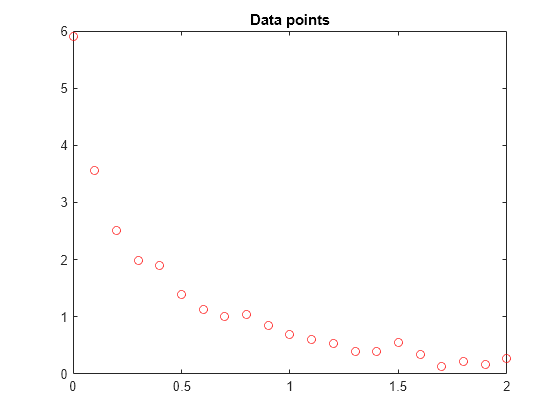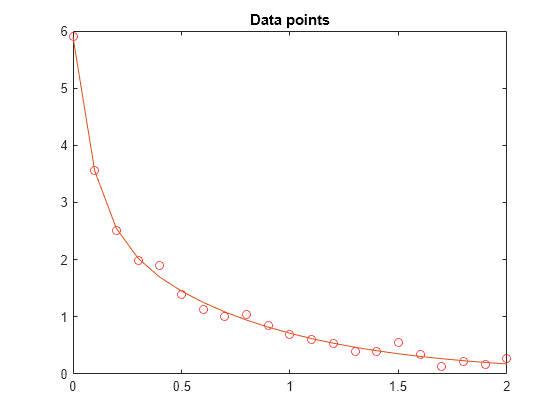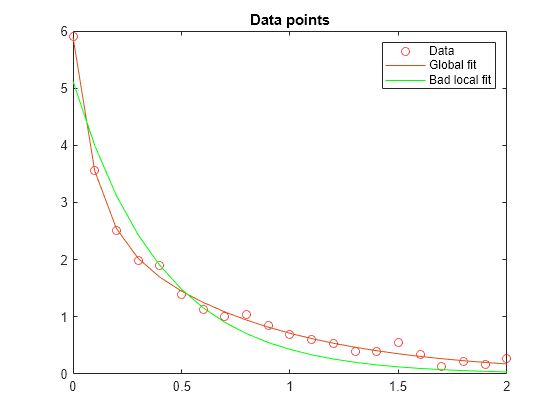Ajuste de datos no lineales empleando varios enfoques basados en problemas
El consejo general para la configuración de problemas de mínimos cuadrados es formular el problema de tal manera que solve reconozca que tiene un formato de mínimos cuadrados. Cuando se hace eso, solve llama internamente a lsqnonlin, que es eficiente para resolver problemas de mínimos cuadrados. Consulte Write Objective Function for Problem-Based Least Squares.
En este ejemplo se muestra la eficiencia de un solver de mínimos cuadrados comparando el rendimiento de lsqnonlin con el de fminunc en el mismo problema. Además, en el ejemplo se muestran ventajas adicionales que se pueden obtener reconociendo explícitamente y gestionando por separado las partes lineales de un problema.
Configuración de problemas
Considere los siguientes datos:
Data = ...
[0.0000 5.8955
0.1000 3.5639
0.2000 2.5173
0.3000 1.9790
0.4000 1.8990
0.5000 1.3938
0.6000 1.1359
0.7000 1.0096
0.8000 1.0343
0.9000 0.8435
1.0000 0.6856
1.1000 0.6100
1.2000 0.5392
1.3000 0.3946
1.4000 0.3903
1.5000 0.5474
1.6000 0.3459
1.7000 0.1370
1.8000 0.2211
1.9000 0.1704
2.0000 0.2636];Represente los puntos de datos.
t = Data(:,1); y = Data(:,2); plot(t,y,'ro') title('Data points')

El problema consiste en ajustar la función
y = c(1)*exp(-lam(1)*t) + c(2)*exp(-lam(2)*t)
a los datos.
Enfoque de solución utilizando el solver predeterminado
Para empezar, defina variables de optimización correspondientes a la ecuación.
c = optimvar('c',2); lam = optimvar('lam',2);
De forma arbitraria, establezca el punto inicial x0 de la forma siguiente: c(1) = 1, c(2) = 1, lam(1) = 1 y lam(2) = 0:
x0.c = [1,1]; x0.lam = [1,0];
Cree una función que calcule el valor de la respuesta en tiempos t cuando los parámetros son c y lam.
diffun = c(1)*exp(-lam(1)*t) + c(2)*exp(-lam(2)*t);
Convierta diffun en una expresión de optimización que suma los cuadrados de las diferencias entre la función y los datos y.
diffexpr = sum((diffun - y).^2);
Cree un problema de optimización con diffexpr como la función objetivo.
ssqprob = optimproblem('Objective',diffexpr);Resuelva el problema utilizando el solver predeterminado.
[sol,fval,exitflag,output] = solve(ssqprob,x0)
Solving problem using lsqnonlin. Local minimum possible. lsqnonlin stopped because the final change in the sum of squares relative to its initial value is less than the value of the function tolerance. <stopping criteria details>
sol = struct with fields:
c: [2×1 double]
lam: [2×1 double]
fval = 0.1477
exitflag =
FunctionChangeBelowTolerance
output = struct with fields:
firstorderopt: 7.8870e-06
iterations: 6
funcCount: 7
cgiterations: 0
algorithm: 'trust-region-reflective'
stepsize: 0.0096
message: 'Local minimum possible.↵↵lsqnonlin stopped because the final change in the sum of squares relative to ↵its initial value is less than the value of the function tolerance.↵↵<stopping criteria details>↵↵Optimization stopped because the relative sum of squares (r) is changing↵by less than options.FunctionTolerance = 1.000000e-06.'
bestfeasible: []
constrviolation: []
objectivederivative: "forward-AD"
constraintderivative: "closed-form"
solver: 'lsqnonlin'
Represente la curva resultante a partir de los valores de la solución devueltos sol.c y sol.lam.
resp = evaluate(diffun,sol); hold on plot(t,resp) hold off

El ajuste tiene el mejor aspecto posible.
Enfoque de solución utilizando fminunc
Para resolver este problema utilizando el solver fminunc, establezca la opción 'Solver' en 'fminunc' al llamar a solve.
[xunc,fvalunc,exitflagunc,outputunc] = solve(ssqprob,x0,'Solver',"fminunc")
Solving problem using fminunc. Local minimum found. Optimization completed because the size of the gradient is less than the value of the optimality tolerance. <stopping criteria details>
xunc = struct with fields:
c: [2×1 double]
lam: [2×1 double]
fvalunc = 0.1477
exitflagunc =
OptimalSolution
outputunc = struct with fields:
iterations: 30
funcCount: 37
stepsize: 0.0017
lssteplength: 1
firstorderopt: 2.9454e-05
algorithm: 'quasi-newton'
message: 'Local minimum found.↵↵Optimization completed because the size of the gradient is less than↵the value of the optimality tolerance.↵↵<stopping criteria details>↵↵Optimization completed: The first-order optimality measure, 9.343600e-07, is less ↵than options.OptimalityTolerance = 1.000000e-06.'
objectivederivative: "forward-AD"
solver: 'fminunc'
Tenga en cuenta que fminunc ha encontrado la misma solución que lsqcurvefit, pero ha necesitado muchas más evaluaciones para hacerlo. Los parámetros para fminunc están en el orden inverso a los de lsqcurvefit; el lam más amplio es lam(2), no lam(1). No resulta sorprendente, ya que el orden de variables es arbitrario.
fprintf(['There were %d iterations using fminunc,' ... ' and %d using lsqcurvefit.\n'], ... outputunc.iterations,output.iterations)
There were 30 iterations using fminunc, and 6 using lsqcurvefit.
fprintf(['There were %d function evaluations using fminunc,' ... ' and %d using lsqcurvefit.'], ... outputunc.funcCount,output.funcCount)
There were 37 function evaluations using fminunc, and 7 using lsqcurvefit.
Dividir los problemas lineales y no lineales
Tenga en cuenta que el problema de ajuste es lineal en los parámetros c(1) y c(2). Esto significa que, para cualquier valor de lam(1) y lam(2), puede utilizar el operador de barra diagonal inversa con el propósito de encontrar los valores de c(1) y c(2) que resuelvan el problema de mínimos cuadrados.
Reformule el problema como problema bidimensional, buscando los mejores valores de lam(1) y lam(2). Los valores de c(1) y c(2) se calculan en cada paso utilizando el operador de barra diagonal inversa tal y como se ha descrito anteriormente. Para hacerlo, utilice la función fitvector, que realiza la operación de barra diagonal inversa para obtener c(1) y c(2) en cada iteración del solver.
type fitvectorfunction yEst = fitvector(lam,xdata,ydata) %FITVECTOR Used by DATDEMO to return value of fitting function. % yEst = FITVECTOR(lam,xdata) returns the value of the fitting function, y % (defined below), at the data points xdata with parameters set to lam. % yEst is returned as a N-by-1 column vector, where N is the number of % data points. % % FITVECTOR assumes the fitting function, y, takes the form % % y = c(1)*exp(-lam(1)*t) + ... + c(n)*exp(-lam(n)*t) % % with n linear parameters c, and n nonlinear parameters lam. % % To solve for the linear parameters c, we build a matrix A % where the j-th column of A is exp(-lam(j)*xdata) (xdata is a vector). % Then we solve A*c = ydata for the linear least-squares solution c, % where ydata is the observed values of y. A = zeros(length(xdata),length(lam)); % build A matrix for j = 1:length(lam) A(:,j) = exp(-lam(j)*xdata); end c = A\ydata; % solve A*c = y for linear parameters c yEst = A*c; % return the estimated response based on c
Resuelva el problema utilizando solve, empezando por un punto inicial bidimensional x02.lam = [1,0]. Para hacerlo, primero convierta la función fitvector en una expresión de optimización utilizando fcn2optimexpr. Consulte Convertir una función no lineal en una expresión de optimización. Para evitar una advertencia, proporcione el tamaño de salida de la expresión resultante. Cree un nuevo problema de optimización con el objetivo como la suma de diferencias al cuadrado entre la función convertida fitvector y los datos y.
x02.lam = x0.lam; F2 = fcn2optimexpr(@(x) fitvector(x,t,y),lam,'OutputSize',[length(t),1]); ssqprob2 = optimproblem('Objective',sum((F2 - y).^2)); [sol2,fval2,exitflag2,output2] = solve(ssqprob2,x02)
Solving problem using lsqnonlin. Local minimum possible. lsqnonlin stopped because the final change in the sum of squares relative to its initial value is less than the value of the function tolerance. <stopping criteria details>
sol2 = struct with fields:
lam: [2×1 double]
fval2 = 0.1477
exitflag2 =
FunctionChangeBelowTolerance
output2 = struct with fields:
firstorderopt: 4.4018e-06
iterations: 10
funcCount: 33
cgiterations: 0
algorithm: 'trust-region-reflective'
stepsize: 0.0080
message: 'Local minimum possible.↵↵lsqnonlin stopped because the final change in the sum of squares relative to ↵its initial value is less than the value of the function tolerance.↵↵<stopping criteria details>↵↵Optimization stopped because the relative sum of squares (r) is changing↵by less than options.FunctionTolerance = 1.000000e-06.'
bestfeasible: []
constrviolation: []
objectivederivative: "finite-differences"
constraintderivative: "closed-form"
solver: 'lsqnonlin'
La eficacia de la solución bidimensional es similar a la de la solución de cuatro dimensiones:
fprintf(['There were %d function evaluations using the 2-d ' ... 'formulation, and %d using the 4-d formulation.'], ... output2.funcCount,output.funcCount)
There were 33 function evaluations using the 2-d formulation, and 7 using the 4-d formulation.
El problema de división es más robusto a la conjetura inicial
Elegir un mal punto de inicio para el problema original de cuatro parámetros hace que se obtenga solución local que no es global. Elegir un punto de inicio con los mismos valores malos lam(1) y lam(2) para el problema de división de dos parámetros hace que se obtenga la solución global. Para mostrarlo, vuelva a ejecutar el problema original con un punto de inicio con el que se obtiene una solución local relativamente mala y compare el ajuste resultante con la solución global.
x0bad.c = [5 1]; x0bad.lam = [1 0]; [solbad,fvalbad,exitflagbad,outputbad] = solve(ssqprob,x0bad)
Solving problem using lsqnonlin. Local minimum possible. lsqnonlin stopped because the final change in the sum of squares relative to its initial value is less than the value of the function tolerance. <stopping criteria details>
solbad = struct with fields:
c: [2×1 double]
lam: [2×1 double]
fvalbad = 2.2173
exitflagbad =
FunctionChangeBelowTolerance
outputbad = struct with fields:
firstorderopt: 0.0036
iterations: 31
funcCount: 32
cgiterations: 0
algorithm: 'trust-region-reflective'
stepsize: 0.0012
message: 'Local minimum possible.↵↵lsqnonlin stopped because the final change in the sum of squares relative to ↵its initial value is less than the value of the function tolerance.↵↵<stopping criteria details>↵↵Optimization stopped because the relative sum of squares (r) is changing↵by less than options.FunctionTolerance = 1.000000e-06.'
bestfeasible: []
constrviolation: []
objectivederivative: "forward-AD"
constraintderivative: "closed-form"
solver: 'lsqnonlin'
respbad = evaluate(diffun,solbad); hold on plot(t,respbad,'g') legend('Data','Global fit','Bad local fit','Location','NE') hold off

fprintf(['The residual norm at the good ending point is %f,' ... ' and the residual norm at the bad ending point is %f.'], ... fval,fvalbad)
The residual norm at the good ending point is 0.147723, and the residual norm at the bad ending point is 2.217300.